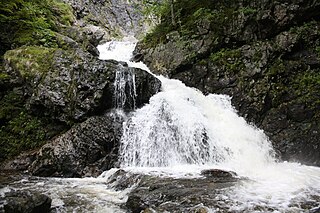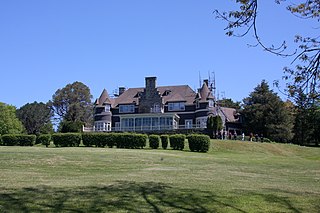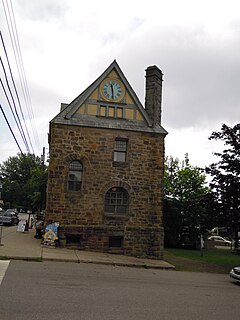The Cabot Trail is a scenic highway on Cape Breton Island in Nova Scotia, Canada. It is a 298 km (185 mi) loop around the northern tip of the island, passing along and through the Cape Breton Highlands and the Cape Breton Highlands National Park.

The Silver Dart was a derivative of an early aircraft built by a Canadian/U.S. team, which after many successful flights in Hammondsport, New York, earlier in 1908, was dismantled and shipped to Baddeck, Nova Scotia. It was flown from the ice of Baddeck Bay, a sub-basin of Bras d'Or Lake, on 23 February 1909, making it the first controlled powered flight in Canada. The aircraft was piloted by one of its designers, Douglas McCurdy. The original Silver Dart was designed and built by the Aerial Experiment Association (AEA), formed under the guidance of Dr. Alexander Graham Bell.

Baddeck is a village in northeastern Nova Scotia, Canada. It is situated in the centre of Cape Breton, where the Baddeck River empties into Bras d'Or Lake.

The Baddeck River is a minor river on Cape Breton Island, Nova Scotia, Canada. It empties into the Bras d'Or Lake several kilometres west of the village of Baddeck.

John Alexander Douglas McCurdy was a Canadian aviation pioneer and the 20th Lieutenant Governor of Nova Scotia from 1947 to 1952.
Baddeck Academy is a Primary through Grade 12 school located in Baddeck, Nova Scotia, Canada, on Cape Breton Island in Victoria County. It is governed by the Cape Breton – Victoria Regional School Board. The Academy overlooks Bras d'Or Lake.

Beinn Bhreagh is the name of the former estate of Alexander Graham Bell, in Victoria County, Nova Scotia. It refers to a peninsula jutting into Cape Breton Island's scenic Bras d'Or Lake approximately three kilometres southeast of the village of Baddeck, forming the southeastern shore of Baddeck Bay.

Alexander Graham Bell National Historic Site is a 10-hectare (25-acre) property in Baddeck, Cape Breton, Nova Scotia, Canada, overlooking the Bras d'Or Lakes. The site is a unit of Parks Canada, the national park system, and includes the Alexander Graham Bell National Historic Site, which contains the largest repository of artifacts and documents from Bell's years of experimental work in Baddeck. This site was designated a National Historic Site in 1952.

Gilbert H. Grosvenor Hall is a historic building in Baddeck, Nova Scotia, Canada. The 19th-century building has served as a post office, library, and interpretive centre.

The Victoria County Court House is a historic building in Baddeck, Nova Scotia.

Saint Peter's and Saint John's Anglican Church is an historic building in Baddeck, Nova Scotia. The church is one of only four remaining churches designed by Reverend Simon Gibbons, Canada's first Inuit priest. Built in 1883, the church is the second of six churches built by Gibbons in Nova Scotia.
St. Mark's Masonic Lodge is a historic Mason's Lodge located at the corner of Queen Street and Grant Street in Baddeck, Nova Scotia. The Lodge was constructed in 1898 to replace a lodge that had been destroyed in a fire.
Baddeck, Nova Scotia is a village founded in 1908, with a history stretching back to early Mi'kmaq, French and British settlements. The village was home to Alexander Graham Bell and was witness to the first flight in the commonwealth with Bell's Silver Dart.

The Kidston Island Lighthouse is a lighthouse on Kidston Island, located in the Bras d'Or lakes, in Baddeck, Nova Scotia. The original lighthouse on Kidston Island was built in 1875. The present lighthouse was built in 1912 and the two stood side by side for some time. The lighthouse can only be accessed by boat; a ferry operates during the summer months.
Baddeck, Nova Scotia is a small village on Cape Breton Island with several historic buildings, including:
Baddeck, Nova Scotia is a small resort town on Cape Breton Island, Canada. Some of its tourist attractions include:

The Telegraph House is a historic hotel located in Baddeck, Nova Scotia.

HD-4 or Hydrodome number 4 was an early research hydrofoil watercraft developed by the scientist Alexander Graham Bell. It was designed and built at the Bell Boatyard on Bell's Beinn Bhreagh estate near Baddeck, Nova Scotia. In 1919, it set a world marine speed record of 70.86 miles per hour (114.04 km/h).

Henry House is a two-and-a-half-storey stone house located on Barrington Street in Halifax, Nova Scotia, Canada. The house is designated a National Historic Site, and is both a Provincially Registered Property and a Municipally Registered Property under the provincial Heritage Property Act.
The Bell Boatyard was a boatbuilding facility which operated as part of Alexander Graham Bell's laboratories in Baddeck, Nova Scotia from 1885 to 1928. The boatyard built experimental craft, lifeboats and yachts during the first part of the twentieth century. The Bell yard was notable for its dual focus on both experimental and traditional boats and for its employment of large numbers of female boatbuilders.













